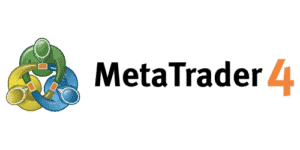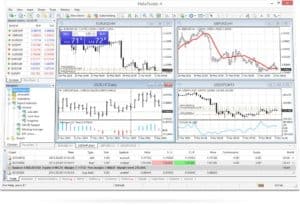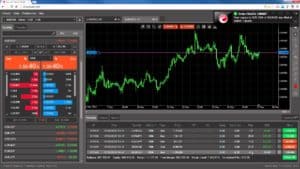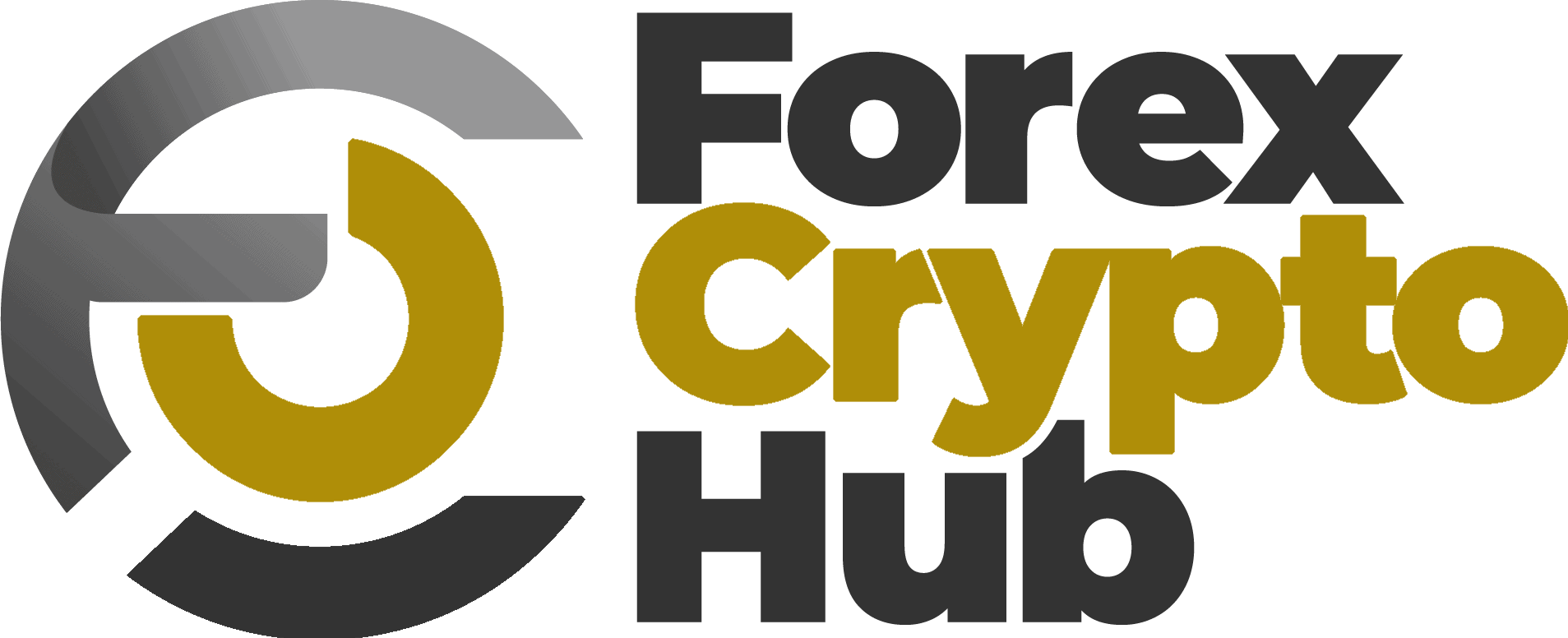Forex For Beginners
Are you a Beginner to the Foreign Exchange Markets?
Our Forex for beginners section will help you get your feet wet in the Forex market.
What is Forex?
The foreign exchange market (Forex, FX, Currency Market) is a global market for the trading of currencies.
This market determines the foreign exchange rate.
It includes all aspects of buying, selling and exchanging currencies at current or determined prices.
In terms of trading volume, it is by far the largest market in the world.
What is an online Forex Broker?
An online Forex broker is a company (a brokerage firm) that organizes transactions between buyers and sellers, and the broker gets a commission once the operation is executed or performed.
In other words, it acts as an intermediary between the two parties in a purchase/sale transaction and charges a commission for its services as a profit. Learn more on What is an online Forex Broker.
Hold On..
More on Forex Market
The Forex market determines the price at which one currency is exchanged for another, which is known as the exchange rate. The Forex market boasts the largest volume of any market in the world.
What makes the Forex market unique? Well, the Forex market is a global decentralized market. It is global in that it operates in the major financial cities of the world—Tokyo, New York, London, Hong Kong, and many others. Because of this decentralization, the Forex market stays open 24 hours a day, 5 days a week—only closing on weekends.
Currency Pairs
Currency pairs
The most widely traded currencies in the foreign exchange market and their symbols include:
- United States dollar (USD)
- Eurozone Euro (EUR)
- Japanese Yen (JPY)
- Great Britain pound (GBP)
- Australian dollar (AUD)
- Canadian dollar (CAD)
- Swiss franc (CHF)
- Chinese Renminbi (CNY)
- Swedish krona (SEK)
- New Zealand dollar (NZD)
Since the Forex market exists to set the exchange rate between currencies, currencies are traded on the Forex market in the form of currency pairs. For example, one currency pair is the EUR/USD, whose price reflects how many U.S. dollars a Euro is worth. When you buy EUR/USD, you are saying that you believe that the Euro will gain value in relation to the United States dollar. If, however, you believed that the U.S. dollar would gain value against the Euro, you would enter a sell order for EUR/USD.
Currency pairs are expressed in the form of the base currency followed by the counter currency (or quote currency). This means that the price of a currency pair is expressed in the counter currency and denotes the amount of the counter currency needed to trade for 1 unit of the base currency.
Over 87% of the trades on the Forex market involve the U.S. dollar. Due to the U.S. dollar’s popularity, the seven currency pairs known as the majors all have the U.S. dollar as a component. They are:
- Euro / U.S. dollar (EUR/USD)
- S. dollar / Japanese Yen (USD/JPY)
- Great Britain pound / U.S. dollar (GBP/USD)
- S. dollar / Swiss franc (USD/CHF)
- S. dollar / Canadian dollar (USD/CAD)
- Australian dollar / U.S. dollar (AUD/USD)
- New Zealand dollar / U.S. dollar (NZD/USD)
Other major world currencies are paired with each other to form what are known as the cross-currency pairs, or simply “crosses.” They are:
- Euro / Great Britain pound (EUR/GBP)
- Euro / Australian dollar (EUR/AUD)
- Great Britain pound / Japanese Yen (GBP/JPY)
- Swiss franc / Japanese Yen (CHF/JPY)
- New Zealand dollar / Japanese Yen (NZD/JPY)
- Great Britain pound / Canadian dollar (GBP/CAD)
Exotic currency pairs are currency pairs like USD/MXN (U.S. dollar / Mexican peso) and EUR/TRY (Euro / Turkish Lira), which pair a major currency with that of an emerging economy. These currency pairs are not very widely traded and trading them can cost a lot in fees because of the difficulty in finding a buyer or seller to complete the order.
Pips
A pip is the smallest unit of measurement in the Forex market. In currency pairs counted in Japanese Yen, one pip is worth .01. In all other currency pairs, its value is .0001. Many brokers now show an extra decimal place, carrying USD/JPY out to 3 decimal places and EUR/USD out to 5, but this only exists with your broker and the Forex market at large doesn’t see it.
Lot Size
Traditionally, the size of a contract in spot forex was of a few standard sizes, known as lots. The standard lot size is 100,000. Later, along came the Mini lot, which is 10,000 units of currency and the Micro lot, which is 1,000 units of currency. Many brokers assign Micro lots to smaller, more beginner-oriented account types and standard to all other accounts. Some brokers today even support odd lots, which means you can buy currency in pretty much any contract size you want.
Dividing the size of a pip in a currency pair by the price and multiplying by the lot size yields the value of each pip in your trade. For example, if you bought a Standard lot of USD/JPY at 106.83, your pip value would be: 0.01 (The size of a pip counted in JPY) / 106.83 x 100,000 = $9.36. This is less important today since your Forex client calculates things like this for you.
Spreads
Spreads are the difference between the bid, the price at which the dealer will pay for a currency, and the ask, the price at which a dealer will sell a currency. This cost reflects the cost incurred by the brokerage in filling a trade. Forex trading software typically displays the spread for you as shown above. If you subtract the bid from the ask, you will find the difference to match the spread of 1.3.
Spreads on major pairs are typically very competitive between brokers and they stay relatively small. Spreads on more exotic and less widely traded currency pairs can get quite large and tend to vary a lot. Equities market have a spread too, but in Forex, the spread is much more transparent.
Margin
Margin, or leverage, is money lent to you by your broker to multiply the buying power of your account. While margin accounts exist in the equities market, a margin account for Forex is much more common and easier to obtain.
While margin provides a great opportunity to leverage additional funds to earn more profits, it also increases risk. Wise money management dictates that you only risk a small percentage of your account in each position you take. A certain percentage of your margin must be available in your account at all times. If this amount is reached or even approached, the broker may make a margin call, which is a request for you to deposit more money. In some cases, your positions may be immediately closed to fulfill the margin requirement. So, treat margin with respect and don’t abuse the privilege.
Fundamental Analysis
In the context of Forex, fundamental analysis is the study of the economic and monetary factors that influence the value of currencies. This is done by analyzing government reports, economic statistics and decisions made by central banks all over the world. The premise behind fundamental analysis is that markets may value an asset wrongly. If a currency is undervalued, it may be a good opportunity to purchase a currency pair composed of that currency in order to take advantage of the price change when the market realizes its “true” price.
The economies and monetary systems of the world are quite complex. Understanding all the variables at play in the fundamental factors of currency prices can be difficult even for experienced analysts and may seem incredibly daunting to a beginner. There is another way to explain and predict the price movements in the Forex market.
Technical Analysis
Technical analysis is the study of the patterns that price has made in the past in an effort to determine what the price will do in the future. The premise behind technical analysis is that the current price reflects all known information about an asset. The patterns created by price action in the market are an expression of this information.
Technical analysis makes use of chart patterns. These chart patterns are created by the buying and selling of an asset. The buying and selling pressure combine to form recognizable patterns that signal a certain event is likely, such as a breakout, or the termination of a trend. We will look at a popular chart pattern below.
Risk Management
Managing your account wisely is a skill that separates hardened, experienced traders from newcomers. It’s not too hard to wipe your entire account if you trade carelessly with no attention to your position size, margin, stops or exit orders.
While many of us may dream of that one big trade that makes us rich and changes our lives forever, the truth is that Forex is a slow, methodical way to make money when done successfully. Solid risk management entails setting a stop-loss every time you open a trade, avoiding putting all your money in one position and limiting the use of leverage.
What is CFD Trading ?
To learn more about Contract for Difference (CFD) trading click the link below.
Please check out this great video for Forex for beginners
Trading platforms
Metatrader – The most popular trading platform for retail forex trading is MetaTrader 4.
Although metatrader 5 is the newest version, MT4 (metatrader 4 ) is the most widely used version.
Metatrader is a well-made platform for using EA’s/expert advisors to auto trade or trading technical tools for generating buy and sell signals.
Metatrader also has a really well made mobile app for mobile trading on your mobile device. To Learn More about MT4 check out our Metatrader 4 guide.

Web based trading platforms – Most brokers have their own web base trading platforms, while most are similar to the metatrader platform featuring charts and technical charting tools, they are usually limited in features.
It’s just another way to trade based on trader preference. To Learn more about MT4 check out our MT4 Guide.
cTrader – cTrader trading platform provides direct STP-access to international currency markets, which means that there are no dealers, re-quotes, or any delays in order execution, and guarantees instant execution of clients’ orders.
The platform is designed to be used with brokers that offer no-dealing desk, real market trading.
This means that when you buy or sell, you are actually making a trade with a real counterparty.


Broker Types
ECN (Electronic Communication Network) – ECN brokers provide and display real-time order book information.
ECN brokers usually make their money by charging a commission on the traded volume.
With ECN brokers, all transactions are directly processed on the interbank market in No Dealing Desk mode.
STP – Straight Through Processing: Transactions are fully computerised and are immediately processed on the interbank market without any broker interference.
Dealing Desk- A dealing desk broker is a Market Maker. Market makers usually offer fixed spreads and may quote above or below actual market prices at any given time.
Market makers are always the counterparty of the trader, who doesn’t trade directly with the liquidity providers.
Market makers get paid through the spreads, and they usually also take the opposite trades of their clients.
Top FX Brokers for Beginners
Top Forex websites
Forex news, forums and forex information for beginners.


